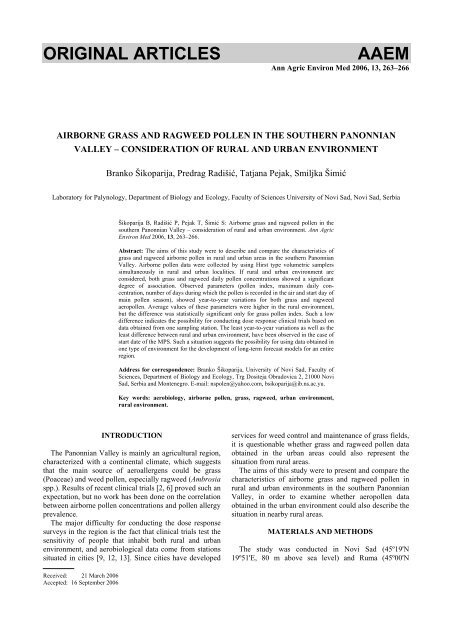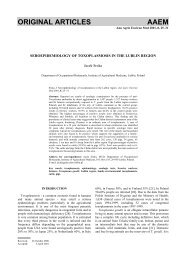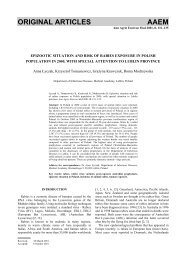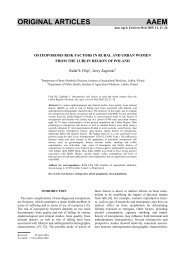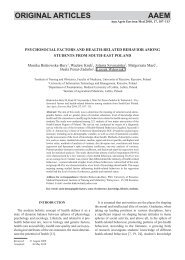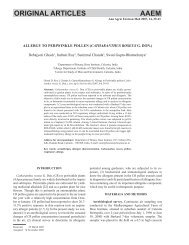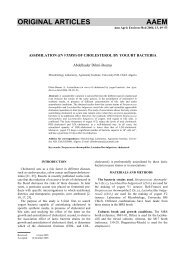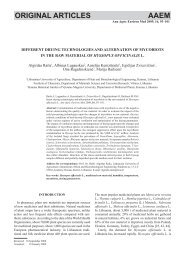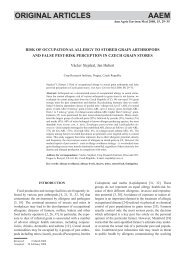AIRBORNE GRASS AND RAGWEED POLLEN IN THE SOUTHERN ...
AIRBORNE GRASS AND RAGWEED POLLEN IN THE SOUTHERN ...
AIRBORNE GRASS AND RAGWEED POLLEN IN THE SOUTHERN ...
Create successful ePaper yourself
Turn your PDF publications into a flip-book with our unique Google optimized e-Paper software.
ORIG<strong>IN</strong>AL ARTICLES<br />
AAEM<br />
Ann Agric Environ Med 2006, 13, 263–266<br />
<strong>AIRBORNE</strong> <strong>GRASS</strong> <strong>AND</strong> <strong>RAGWEED</strong> <strong>POLLEN</strong> <strong>IN</strong> <strong>THE</strong> SOU<strong>THE</strong>RN PANONNIAN<br />
VALLEY – CONSIDERATION OF RURAL <strong>AND</strong> URBAN ENVIRONMENT<br />
Branko Šikoparija, Predrag Radišić, Tatjana Pejak, Smiljka Šimić<br />
Laboratory for Palynology, Department of Biology and Ecology, Faculty of Sciences University of Novi Sad, Novi Sad, Serbia<br />
Šikoparija B, Radišić P, Pejak T, Šimić S: Airborne grass and ragweed pollen in the<br />
southern Panonnian Valley – consideration of rural and urban environment. Ann Agric<br />
Environ Med 2006, 13, 263–266.<br />
Abstract: The aims of this study were to describe and compare the characteristics of<br />
grass and ragweed airborne pollen in rural and urban areas in the southern Panonnian<br />
Valley. Airborne pollen data were collected by using Hirst type volumetric samplers<br />
simultaneously in rural and urban localities. If rural and urban environment are<br />
considered, both grass and ragweed daily pollen concentrations showed a significant<br />
degree of association. Observed parameters (pollen index, maximum daily concentration,<br />
number of days during which the pollen is recorded in the air and start day of<br />
main pollen season), showed year-to-year variations for both grass and ragweed<br />
aeropollen. Average values of these parameters were higher in the rural environment,<br />
but the difference was statistically significant only for grass pollen index. Such a low<br />
difference indicates the possibility for conducting dose response clinical trials based on<br />
data obtained from one sampling station. The least year-to-year variations as well as the<br />
least difference between rural and urban environment, have been observed in the case of<br />
start date of the MPS. Such a situation suggests the possibility for using data obtained in<br />
one type of environment for the development of long-term forecast models for an entire<br />
region.<br />
Address for correspondence: Branko Šikoparija, University of Novi Sad, Faculty of<br />
Sciences, Department of Biology and Ecology, Trg Dositeja Obradovica 2, 21000 Novi<br />
Sad, Serbia and Montenegro. E-mail: nspolen@yahoo.com, bsikoparija@ib.ns.ac.yu.<br />
Key words: aerobiology, airborne pollen, grass, ragweed, urban environment,<br />
rural environment.<br />
<strong>IN</strong>TRODUCTION<br />
The Panonnian Valley is mainly an agricultural region,<br />
characterized with a continental climate, which suggests<br />
that the main source of aeroallergens could be grass<br />
(Poaceae) and weed pollen, especially ragweed (Ambrosia<br />
spp.). Results of recent clinical trials [2, 6] proved such an<br />
expectation, but no work has been done on the correlation<br />
between airborne pollen concentrations and pollen allergy<br />
prevalence.<br />
The major difficulty for conducting the dose response<br />
surveys in the region is the fact that clinical trials test the<br />
sensitivity of people that inhabit both rural and urban<br />
environment, and aerobiological data come from stations<br />
situated in cities [9, 12, 13]. Since cities have developed<br />
services for weed control and maintenance of grass fields,<br />
it is questionable whether grass and ragweed pollen data<br />
obtained in the urban areas could also represent the<br />
situation from rural areas.<br />
The aims of this study were to present and compare the<br />
characteristics of airborne grass and ragweed pollen in<br />
rural and urban environments in the southern Panonnian<br />
Valley, in order to examine whether aeropollen data<br />
obtained in the urban environment could also describe the<br />
situation in nearby rural areas.<br />
MATERIALS <strong>AND</strong> METHODS<br />
The study was conducted in Novi Sad (45º19'N<br />
19º51'E, 80 m above sea level) and Ruma (45º00'N<br />
Received: 21 March 2006<br />
Accepted: 16 September 2006
264 Šikoparija B, Radišić P, Pejak T, Šimić S<br />
19º49'E, 105 m above sea level), which are approximately<br />
45 km apart with 800 m high mountains between. Crop<br />
fields surround both cities. Novi Sad could be considered<br />
as urban environment since its inhabitants live mostly in<br />
multi-storey buildings, green areas are limited to city<br />
parks and there is a public service for weed control and<br />
maintenance of grass fields. On the other hand, Ruma<br />
should be considered as a rural environment since people<br />
live in family houses surrounded by gardens, and there is<br />
no such public service.<br />
Pollen samples were collected simultaneously in both<br />
cities by Hirst volumetric method [5] during the period<br />
2003-2005. Silicone fluid was used as the adhesive<br />
substance and gllycerine-yelly stained with basic fuchsine<br />
as the mounting medium. Sampling tape was divided into<br />
48 mm segments, each corresponding to 24 hours. Five<br />
horizontal scans were performed over each segment at a<br />
magnification of 400×, pollen was determined and<br />
counted and the results expressed as the daily pollen<br />
concentration (pg/m 3 ). Daily pollen concentrations, pollen<br />
index (annual sum of daily pollen concentrations), maximum<br />
concentrations and number of days during which<br />
pollen is recorded in the atmosphere are presented and<br />
compared. The determination of the main pollen season<br />
(MPS) is important for data comparison both between<br />
different years and different monitoring sites, and is often<br />
used for development of pollen forecast models since it<br />
eliminates incidental occurrence through localised flowering<br />
at the start of the season, as well as the<br />
contribution of long distance transported pollen [3].<br />
Therefore, the start day of the main pollen season was<br />
identified as the day when the sum of the daily pollen<br />
concentrations reached 2.5% [8].<br />
Table 1. Spearman’s correlation coefficients obtained by comparison of<br />
daily pollen concentrations in rural and urban environment on a yearly<br />
basis as well as 3-year average.<br />
Pollen concentration 2003 2004 2005 Average<br />
Grass a 0.716 0.938 0.848 0.953<br />
Ragweed a 0.889 0.885 0.958 0.912<br />
a p
Grass and ragweed aeropollen in rural and urban environments 265<br />
140<br />
3<br />
pg/m 2003<br />
Ruma<br />
120<br />
Novi Sad<br />
1000<br />
3<br />
pg/m<br />
2003<br />
Ruma<br />
Novi Sad<br />
100<br />
800<br />
80<br />
600<br />
60<br />
40<br />
400<br />
20<br />
200<br />
0<br />
0<br />
140<br />
120<br />
2004<br />
1000<br />
2004<br />
100<br />
800<br />
80<br />
600<br />
60<br />
40<br />
400<br />
20<br />
200<br />
0<br />
0<br />
140<br />
120<br />
2005<br />
1000<br />
2005<br />
100<br />
800<br />
80<br />
60<br />
40<br />
20<br />
months<br />
0<br />
J F M A M J J A S O N D<br />
600<br />
400<br />
200<br />
months<br />
0<br />
J F M A M J J A S O N D<br />
Figure 1. Running mean daily airborne grass pollen concentrations in<br />
Ruma and Novi Sad for 2003-2005.<br />
According to calculated standard deviation values, pollen<br />
index and maximum daily concentration have shown high<br />
year-to-year variations, which were higher in the case of<br />
ragweed pollen. In addition, the average values both for<br />
grass (Tab. 2) and ragweed (Tab. 3) pollen higher values<br />
in the rural environment. Statistically, the difference was<br />
significant only in the case of grass pollen index.<br />
Both for grass (Tab. 2) and for ragweed (Tab. 3) pollen,<br />
the least year-to-year variations were observed for the<br />
number of days during which pollen was recorded in the<br />
air, as well as for the start day of the MPS. As a result, the<br />
average start day of MPS was the same in both the rural<br />
and urban environments.<br />
DISSCUSION<br />
Pollen index and maximum concentrations of grass<br />
pollen in the observed region were lower compared to<br />
other regions in Europe [4, 14]. On the other hand the<br />
quantitative parameters of ragweed pollen obtained in this<br />
study showed significantly higher values than observed in<br />
the other European regions [1, 7, 11, 15, 17]. Year-to-year<br />
variations of grass and ragweed pollen parameters<br />
correspond to results obtained in the studies cited above.<br />
Figure 2. Running mean daily airborne ragweed pollen concentrations in<br />
Ruma and Novi Sad for 2003-2005.<br />
As suggested in the study by Trigo et al. [16], the high<br />
degree of association between the data obtained in rural<br />
and urban environment indicates the possibility for<br />
building long-term forecast models for one monitoring<br />
station, based on readings taken in other station.<br />
The actions of the public service which maintain grass<br />
fields in the urban environment, might result in the<br />
significant difference in average grass pollen index<br />
observed in the present study. The medium distance<br />
transport of ragweed pollen from crop fields could make<br />
the difference between average ragweed pollen indexes of<br />
the rural and urban environments less distinctive. Other<br />
observed parameters showed small differences in average<br />
values, which suggest that the data obtained in one trap<br />
could be used for the development of long-term forecast<br />
models for an entire region, especially for predicting the<br />
start of grass and ragweed MPS. This possibility could be<br />
considered important since it is often easier to obtain<br />
meteorological data from cities.<br />
According to previous studies, daily pollen concentration<br />
significantly correlate to local weather parameters<br />
[4, 7, 10, 11, 15], and local changes in weather could<br />
change the distribution and intensity of annual peaks.<br />
Therefore, observed differences in distribution and inten-
266 Šikoparija B, Radišić P, Pejak T, Šimić S<br />
sity of peaks suggest that local pollen and local meteorological<br />
data should be used for building short-term<br />
forecast models.<br />
CONCLUSION<br />
The high association between data of both pollen types<br />
measured in rural and urban environment, as well as the<br />
insignificant difference between average values, suggest<br />
the possibility for development of regional long-term<br />
forecast models based on pollen data obtained from one<br />
monitoring station in the region. Such an opportunity<br />
could be considered important since often it is not<br />
possible to obtain local meteorological data for both<br />
environments, but further studies should be conducted in<br />
order to develop the regional long term forecast models<br />
and to examine their accuracy.<br />
REFERENCES<br />
1. Belmonte J, Vendrell M, Roure JM, Vidal J, Cadahia A: Levels of<br />
Ambrosia pollen in the atmospheric spectra of Catalan aerobiological<br />
stations. Aerobiologia 2000, 16, 93-99.<br />
2. Burazer L, Vuckovic O, Gavrovic M, Cirkovic, T: Allergic<br />
diseases – an increasing problem in Serbia and Montenegro. In: EAAC<br />
(Eds): Aerobiology and Environment. Proceedings of the EAACI<br />
Summer School Madeira 19-23 August 2004, European Academy of<br />
Allergology and Clinical Immunology (EAACI). URL:<br />
http://www.eaaci.net/site/Madeira_Summer_Course_Abstracts.doc<br />
(retreived 12 March 2006).<br />
3. Emberlin J, Mullins J, Corden J, Millington W, Broke M, Savage<br />
M, Jones S: The trend to earlier Birch pollen season in the UK: A biotic<br />
response to changes in weather conditions? Grana 1997, 36, 29-33.<br />
4. Galan C, Cuevas J, Infante F, Dominguez E: Seasonal and diurnal<br />
variation of pollen from Gramineae in the atmosphere of Cordoba<br />
(Spain). Allergol Immunopathol (Madr) 1989, 17, 245-249.<br />
5. Hirst JM: An automatic volumetric spore trap. Ann Appl Biol<br />
1952, 39, 257.<br />
6. Kadocsa E, Juhász M: Study of airborne pollen composition and<br />
allergen spectrum of hay fever patients in South Hungary (1990-1999).<br />
Aerobiologia 2002, 18, 203-209.<br />
7. Laaidi K, Laaidi M: Airborne pollen of Ambrosia in Burgundy<br />
(France) 1996-1997. Aerobiologia 1999, 15, 65-69.<br />
8. Pathirane L: Graphical determination of the main pollen season.<br />
Pollen and spores 1975, 17, 609-610.<br />
9. Peternel R, Čulig J, Mitić B, Vukušić I, Šoštar Z: Analysis of<br />
airborne pollen concentrations in Zagreb, Croatia. Ann Agric Environ<br />
Med 2002, 10, 107-112.<br />
10. Puc M, Puc MJ: Allergenic airborne grass pollen in Szczecin. Ann<br />
Agric Environ Med 2004, 11, 237-244.<br />
11. Puc M: Ragweed pollen in the air of Szczecin. Ann Agric Environ<br />
Med 2004, 11, 53-57.<br />
12. Radišić P, Šikoparija B, Juhasz M, Ianovici N: Airborne pollen of<br />
Corylus in the Danube-Kris-Mures-Tisa Euroregion. Cent Eur J Occup<br />
Environ Med 2004, 10, 35-40.<br />
13. Radišić P, Šikoparija B: Betula spp. pollen in the atmosphere of<br />
Novi Sad (2000-2002). Aerobiologia 2004, 21, 63-67.<br />
14. Spieksma FThM, Corden JM, Detandt M, Millington WM,<br />
Nikkels H, Nolard N, Schoenmakers CHH, Wachter R, de Weger LA,<br />
Willems R, Emberlin J: Quantitative trends in annual totals of five<br />
common airborne pollen types (Betula, Quercus, Poaceae, Urtica, and<br />
Artemisia), at five pollen-monitoring stations in western Europe.<br />
Aerobiologia 2003, 19, 171-184.<br />
15. Stepalska D, Szczepanek K, Myszkowska D: Variation in<br />
Ambrosia pollen concentration in Southern and Central Poland in 1982-<br />
1999. Aerobiologia 2002, 18, 13-22.<br />
16. Trigo MM, Toro FJ, Recio M, Cabezudo B: A statistical approach<br />
to comparing the results from different aerobiological stations. Grana<br />
2000, 39, 252-258.<br />
17. Yankova R, Zlatev V, Baltadijeva D, Mustakov T, Mustakov B:<br />
Quantitative dynamics of Ambrosia pollen grains in Bulgaria.<br />
Aerobiologia 2000, 16, 299-301.


